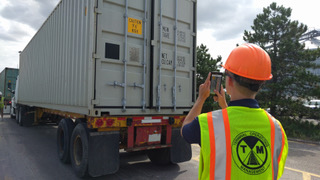TCompanies app verifies damage to shipping containers

TCompanies' "PEIRS" product lets drivers use their smartphones to snap pictures of damaged assets. The technology promises to make the claims process quicker and less costly.
Transportation technology provider TCompanies Inc. today said it had released a cloud-based application designed to streamline the tracking and assessment of damaged shipping containers.
The product, known as Photo Equipment Interchange Receipt (PEIR), allows drivers to use their own smartphones to photograph dented containers and other physical assets such as truck chassis, then create an irrefutable digital record of the photograph using Blockchain software.
Blockchain technology provides a "distributed ledger" of digital breadcrumbs that verify the identity of digital records by ensuring they cannot be changed without the consensus of all parties involved. Supply chain operators have been finding an increasing number of applications for the technology to improve data security and create so-called "self-executing contracts."
Applying blockchain to container tracking could help ports, trucking companies, rail terminals, container depots, and DCs to better manage the labor, legal, and insurance costs relating to replacing or repairing damaged shipping containers, according to Henderson, Nev.-based TCompanies.
Currently, supply chain partners settle damage claims to pay for dented or broken shipping containers through a manual chain of phone calls and diagrams based on the equipment interchange report (EIR) standard. The time and cost of that works adds up quickly when multiplied by the world's estimated 17 million metal shipping containers and their approximately 200 million trips a year, TCompanies CEO Tom Burke said in a statement.
By adding verified photographs of every damage claim, the PEIR application allows firms to avoid disputes over the timing, location, or extent of damage. "It's not surprising that large numbers [of containers] are damaged at some point during transit, and the process in determining who was at fault for the damage is a problem in terms of man hours and potential legal costs for all involved in interchange points: ports, trucking companies, rail terminals, distribution centers, and container depots," Burke said. "PEIR solves this problem with visible, irrefutable recordable evidence within Blockchain."
After a driver opens PEIR on a smartphone, the app prompts the user through a series of questions about the container's size, whether it is full or empty, whether it shows any visible damage, and the proper angle for snapping a series of 7 to 12 photos. PEIR stamps that data with the date, time, and location, then authenticates that information through Blockchain.
Once a company has that data, it can avoid expensive and time-consuming disputes over damage claims, a process that usually falls on trucking companies even though the containers are also handled by shipping lines, ports, and rail yards, Burke said. "There is a lot of opportunity for damage to happen, but typically the trucking company is held responsible for damage," Burke said in an interview. "This app will put an end to that, because now they can say 'No, it was damaged when I picked up' or 'It wasn't damaged when I dropped it off,' "
Related Articles

Copyright ©2024. All Rights ReservedDesign, CMS, Hosting & Web Development :: ePublishing